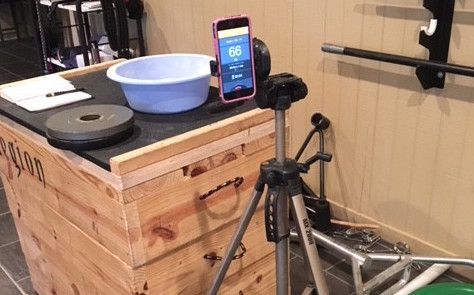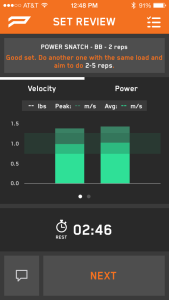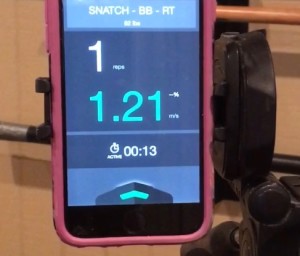NOTE: I AM NOT AFFILIATED WITH PUSH STRENGTH NOR IS THE LINK IN THIS ARTICLE AN AFFILIATE LINK. THIS IS JUST MY PERSONAL EXPERIENCE AND OPINION USING THE DEVICE.
As you may know, I train largely by myself. Which means I video a lot of my lifts to dissect afterwards. But an even more useful tool is my PUSH band. I first wrote about it at this link if you want to learn some of the basics: Review of Push-Band
The PUSH band is basically like an affordable Tendo unit. It’s an accelerometer that is worn on your forearm that measures bar speed- both peak and average- throughout the lift.
For olympic weightlifters, peak bar speed is, I believe, a nice measure of speed at the end of the second pull. This is a measure of the power you were able to generate with your pull. It also gives you power readings for your lift (you input the weight on the bar) but I think bar speed is more reliable lift to lift.
Now previously you could only look at this data after your set was done as seen here:
But a recent update to the software means you can now watch your lifts in near real time, i.e., a second or so after completion.
I keep my phone with the bluetooth linked program propped on a tripod where I can clearly see the screen while I lift.
This feature is most useful to me on sets where I need to do more than 1-2 reps, for example, squats. Now I am not a natural squatter. My secret of secrets is that I kinda hate squats (I know, that’s not good for an olympic lifter, but there you go. I like pulling, not squatting). I always feel like I’m going to get crushed to death. So I’m a giant wimp about squats.
Left to my own devices, I am likely to wimp out on squats as soon as they “feel hard”. What’s valuable about real time data is that it can tell me if the squat was actually hard as opposed to just feeling hard. By watching average bar speed, I can look at when a squat actually starting becoming a grinder, i.e., when did I actually start slowing down during the lift.
So now I tend to push myself one to two sets more and 5-15lbs heavier than I used to with squats. Because by seeing that what felt hard actually went up easily, I build the mental confidence to push for more. It’s also actual data as opposed to the subjective “yuck this feels hard.”
A few sets with a few extra pounds may not sound like much but when you squat every day (which, at the moment, I do) that volume actually adds up pretty fast. I think it is why I’m already seeing more out of frequent squatting this time around than I did back in January.
There is also a feature in the real time update that lets you pick a speed range by telling the program what your objective is. If you tell it “strength” is your goal, it has one set of suggested speed parameters. If you tell it “power”, then it has a different set of parameters. But either way, it will ding after a rep to let you know if the rep was good (in the range) or bad (too slow).
It has also provided interesting data on my olympic lifts. I have noticed that the speed and power don’t vary much from my working sets (70-85%) to my sets with a failure (usually 90-95%). This tells me that it’s not a strength issue, per se, but likely more of a technique issue. Maybe failing to keep the bar close or wimping out and moving elbows slowly in the clean for example.
So here is a video of me using the PUSH while doing some fairly light snatch doubles. You can see the tripod in front of me and inset is a shot of the screen.
You can see on the screen inset that it counts reps at the top (the “1”) and then average bar speed below it (the “1.21”). Useful data when you’re training alone to know when to stop and take a rest even if form “feels” ok.
If you’re interested in learning more about the PUSH or interesting in purchasing one, this is their website:
They also have 1RM calculator software which my husband and I are eager to try. The 1RM works on your data from sub-maximal loads of your lifts. I’m currently having trouble with the PUSH picking up all my deadlift reps which obviously needs fixing before I can test that lift, but it does well on almost every other lift except jerks off blocks (where it also misses reps).


